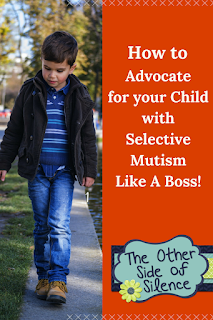Update!
Hi everyone! I know I have been absent on this blog since the start of fall and I wanted to update you on what has been going on.
Hi everyone! I know I have been absent on this blog since the start of fall and I wanted to update you on what has been going on.
This blog was created a few years back to document our family's journey with Selective Mutism. Since my son was diagnosed 4 years ago at the age of 3, we have learned so much and have experienced the incredible highs and lows of parenting a child with SM. With the help of the Smart Center, supportive school teachers and staff, my husband and I working hard every single day to advocate for our son, and most of all our son's brave efforts, I am proud to say that Thomas has truly conquered his Selective Mutism! Sure, he still has anxiety about certain things, but he is now verbal in all settings- at school, with peers and adults, at stores, restaurants, on sports fields, and so on.
Even though our PERSONAL journey with Selective Mutism is coming to an end, it does not by any means imply that I am done helping others with their SM journey. Over the years, I have had the opportunity to speak with so many wonderful families who are trying to figure out how to best help their children with SM. They have the same questions and fears that we did when we started out and over time I began to see a common theme in several of these children. The majority of them could be described as "highly sensitive."
What does it mean to be "Highly Sensitive?"
High Sensitivity is a biological trait that 15 to 20 percent of children are born with. It is not a flaw, weakness or disorder. A highly sensitive person feels things deeply, tends to notice more in their environment, is easily overstimulated and reflects on things intently before acting. They are often incredibly observant, cautious and overstimulated more easily by sensory input in their environment, such as bright lights, smells, crowds and loud noises.
Highly sensitive people are very in tune with the emotions and feelings of others around them, as well. They take in the feelings of people and often have very strong emotional reactions. Due to the fact that they feel and process things more deeply, downtime is very important. They need to be able to remove themselves from others and environments that overstimulate them. This allows them to recharge and is essential to their well-being.
Highly sensitive people are very in tune with the emotions and feelings of others around them, as well. They take in the feelings of people and often have very strong emotional reactions. Due to the fact that they feel and process things more deeply, downtime is very important. They need to be able to remove themselves from others and environments that overstimulate them. This allows them to recharge and is essential to their well-being.
What's Next
Figuring out that Thomas was highly sensitive answered many questions I had and provided me with a better understanding of how to help my son with his SM. Just like Selective Mutism, the term 'Highly sensitive' is not widely known and it is so misunderstood! In my pursuit to help other families in their SM journey, I have created the site, The Highly Sensitive Child, which aims to help parents understand and appreciate their highly sensitive children (HSCs). If you feel that your child with Selective Mutism may be highly sensitive, I strongly encourage you to check out what it has to offer. It focuses more on younger children, since this is my experience, but there may be some information that could be relevant for teens as well.
This personal blog, The Other Side of Silence, will still be here for you to access. It tells of our journey with SM and I intend to keep this up as a reference to help other families with the same questions and struggles. I will no longer be adding to this site, as it was a personal journey of how my son overcame SM. Since overcoming SM is no longer a part of our daily personal journey, there is nothing new to add. However, this does not mean that I am done helping other families going through the same challenges we went through.
My new site, The Highly Sensitive Child, focuses more on educating and advising parents with HSCs and those struggling with SM, rather than sharing a personal story. I really hope you will visit to learn more.
Is your Child Highly Sensitive?
I am curious as to how many of you feel that your child with Selective Mutism may also be highly sensitive? Have you ever heard of the term before? If you feel that this may apply to your child, I encourage you to check out my site- The Highly Sensitive Child.and and join our Facebook community Parents of Highly Sensitive Children, where you will join a growing community of other parents working to understand and help their highly sensitive kids. Share your story, ask questions, and get feedback from parents going through the same challenges as you.
Have any questions, comments, or concerns? Please feel free to contact me at thehighlysensitivechild@gmail.com
Have any questions, comments, or concerns? Please feel free to contact me at thehighlysensitivechild@gmail.com









